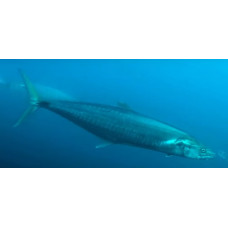Latin name
Scomberomorus commerson
Other names
Scomberomorus commerson
Identification
They have an elongated torpedo-shaped body, compressed at the sides. Their height is 5-6.3 times less than their body length. Thin tail peduncle with a simple keel. The large teeth are triangular. The head is large and pointed, its length is 4.3-5.1 times less than the length of the body. The swim bladder is absent. The length of the snout is shorter than the rest of the head. Coulter and palatine teeth are present. The maxilla is not hidden under the premaxilla. The lateral line is not wavy, but curves sharply under the second dorsal fin. Teeth on the tongue are absent. Number of gill rays on first gill arch 1-8. Vertebrae 42-46.
Features of fish fins
The 2 dorsal fins are separated by a small gap. The pelvic fins are small. The spur between the pelvic fins is small and bifurcated. The first dorsal fin has 15-18 barb rays, the second dorsal fin has 15-20 barb rays and the anal fin has 16-21 soft rays. Behind the second dorsal and anal fins is a series of smaller fins (8-10 and 7-12 respectively), which help to avoid vortex formation during rapid movement. The pectoral fins are made up of 21-24 rays.
Fish colouring
Back dark blue. Flanks silvery steel with many dark transverse wavy stripes.
Distribution
It inhabits the coastal waters of the Indian Ocean and the western Pacific Ocean: from the Red Sea to the Knysna Lagoon (South Africa), off the coast of Madagascar, India, Sri Lanka, Korea, China, Japan and the Philippines. They migrate through the Suez Canal to the eastern Mediterranean. In the Atlantic, the species has been recorded off St Helena.
Habitat
Epipelagic, neritic, marine, oceanodromous and tropical fish are kept at depths of up to 200 metres.
Size
The maximum recorded length is 240 cm and the maximum mass is 70 kg. The average length does not exceed 90 cm and the mass does not exceed 14 kg.
Behavior
They migrate seasonally. Pelagic social fish living near the edge of the continental shelf in shallow coastal waters, often with low salinity and high turbidity, also found in drop-offs and shallow or flat waters of reefs and lagoons.
Food and feeding habits
It feeds around the clock. Small fish (anchovies, small herring, sardines, mackerel), shrimp and squid form the basis of its diet.
Reproduction
The spawning season is long. In Australian waters, each female spawns several times per season with an interval of 2-6 days. The fish spawn on reef slopes. Eggs and larvae are pelagic. Spawning peaks in October-July off East Africa, December-February off Madagascar, May-July of Hindustan and in spring off Taiwan Island. Males and females reach sexual maturity at about 2 years of age, at 65 cm and 70 cm respectively. Life span is estimated at 22 years. Generation length is approximately 8-9 years.
Fishing
Valuable commercial fish with high quality white flesh.
Relationship with a person
It is mainly sold fresh, but also frozen, smoked, canned and salted. There have been reports of ciguatera poisoning.
| Classification | |
| Phylum | Chordata |
| Class | Actinopterygii |
| Squad | Scombriformes |
| Family | Scombridae |
| Genus | Scomberomorus |
| Species | S. commerson |
| Features | |
| Conservation status | Near Threatened |
| Habitat | Pelagic |
| Life span, years | 22 |
| Maximum body weight, kg | 70 |
| Maximum length, cm | 240 |
| Sailing speed, m/s | No information |
| Threat to people | Edible |
| Way of eating | Predator |



